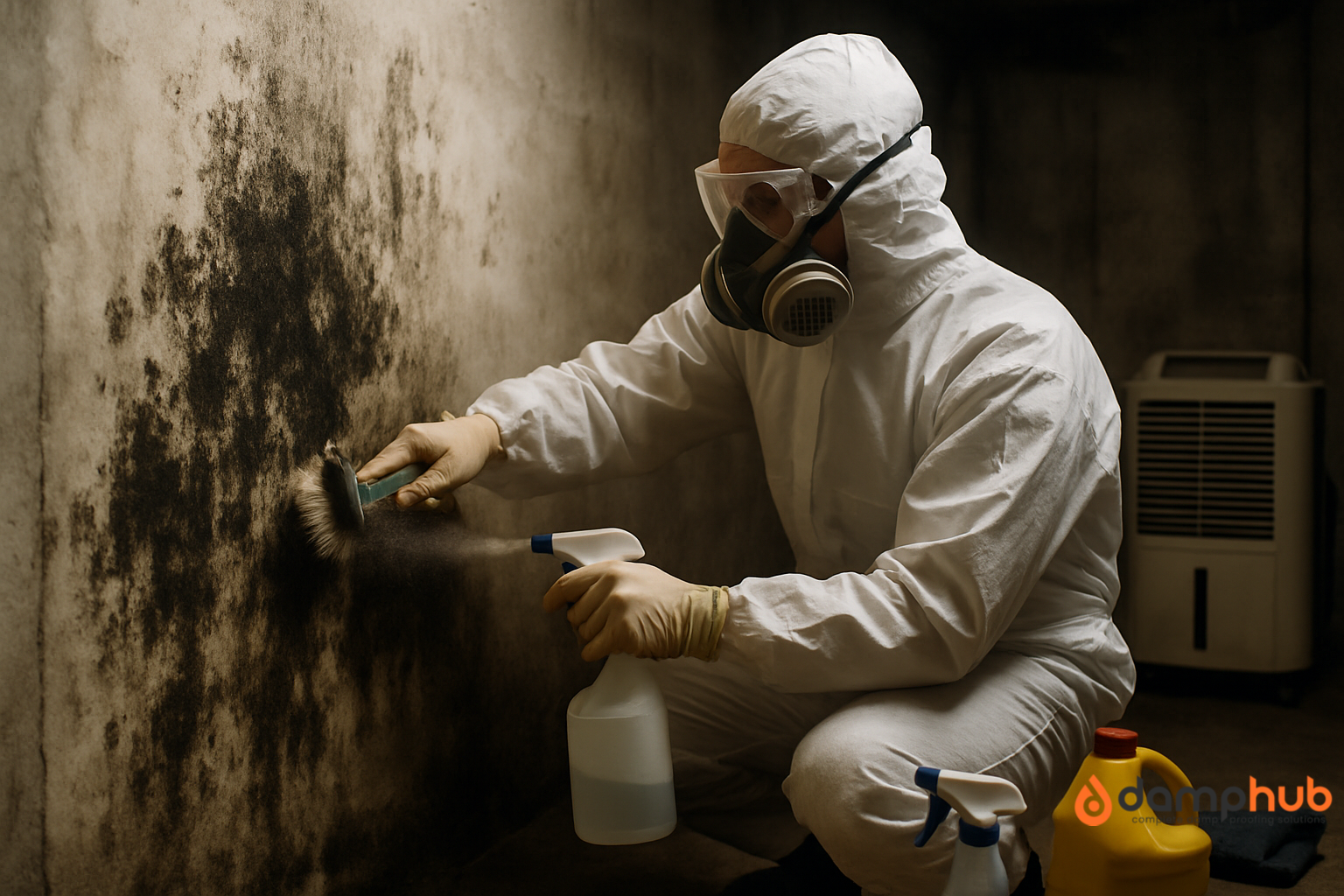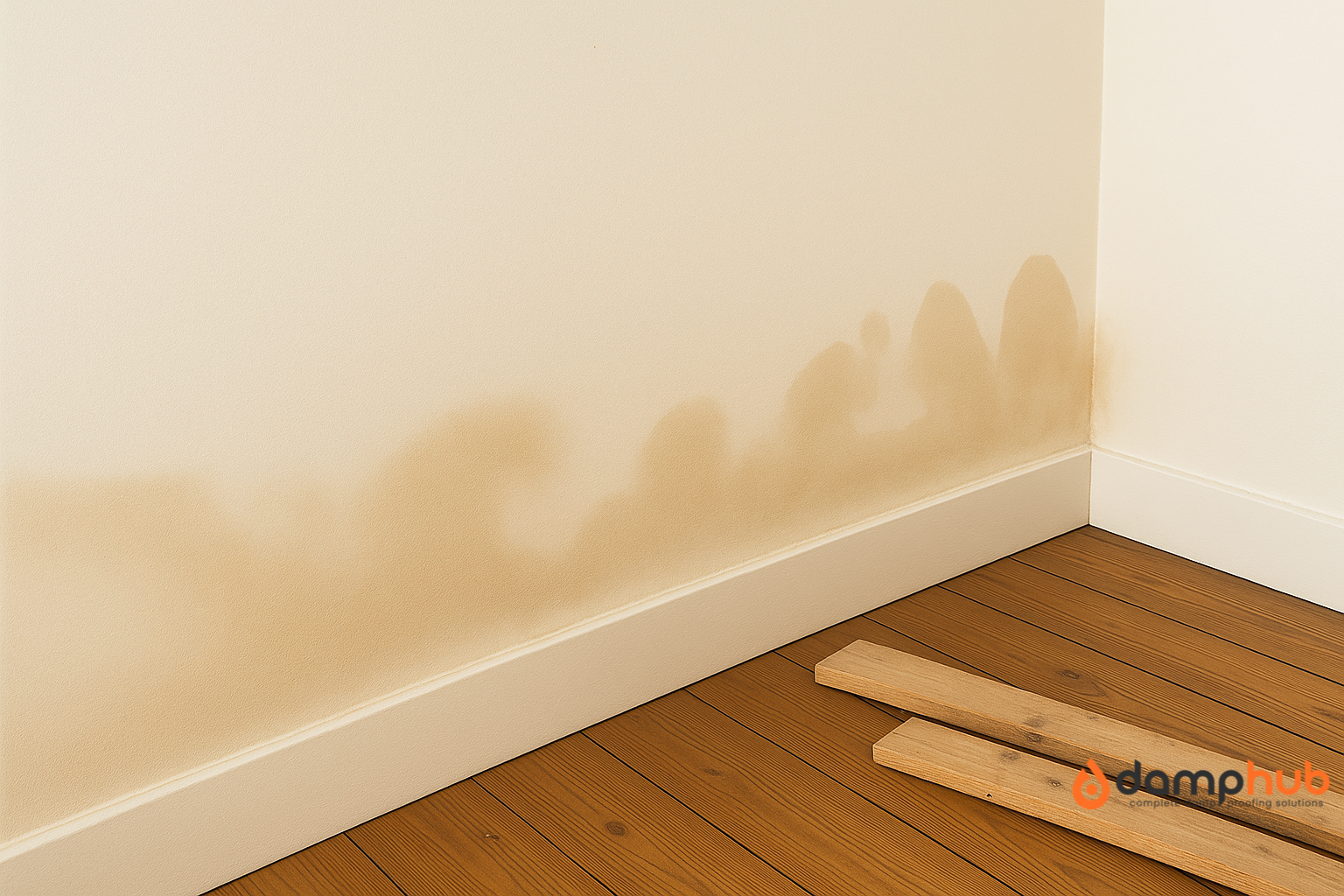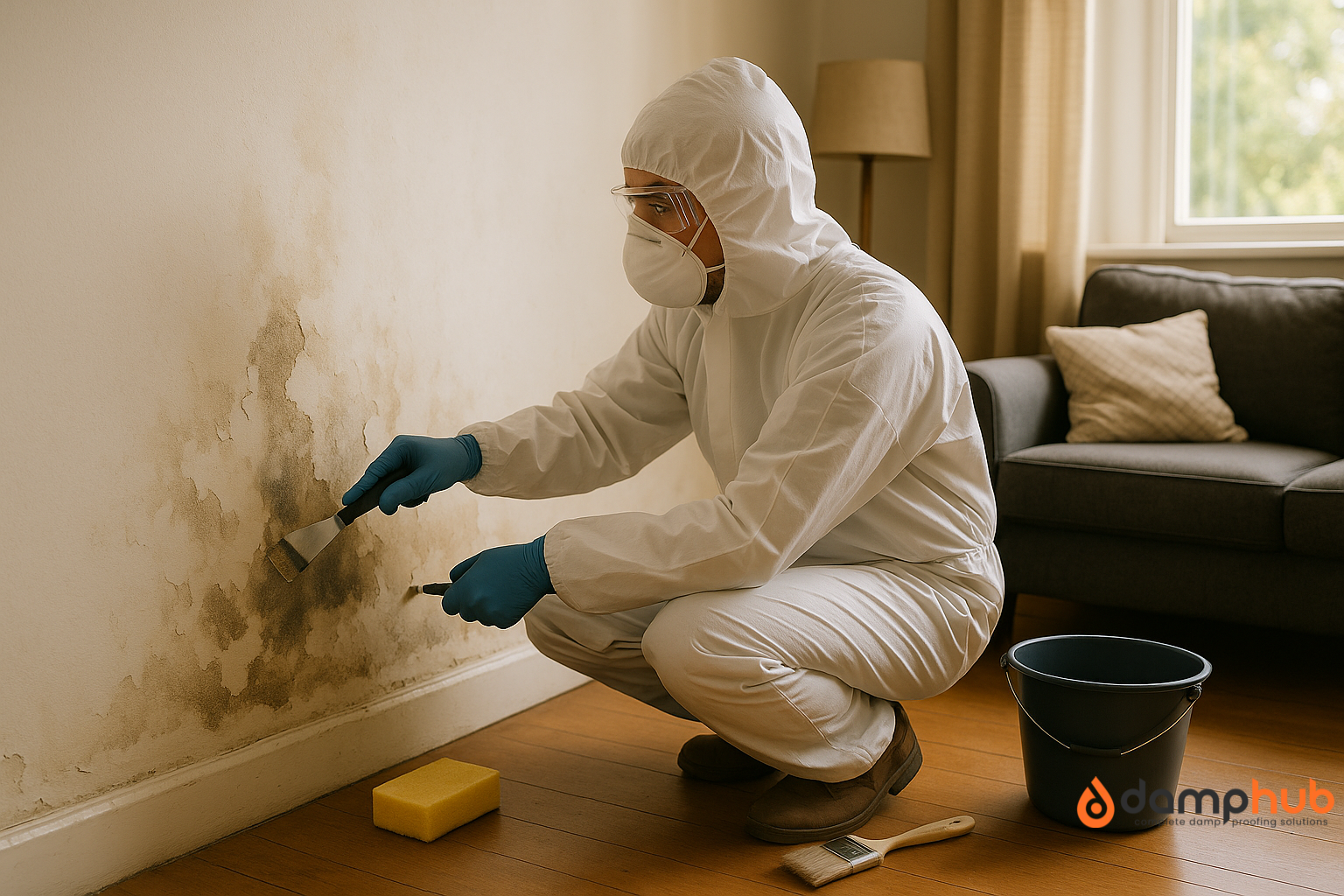
Have you ever looked around and found your wall looks… off? The bricks are covered in a white, chalky powder, like someone dusted them with flour.
Maybe it’s creeping across your patio slabs. Maybe it’s on your basement wall, flaking through the paint you only just finished.
Looks harmless, right? That’s efflorescence.
And while it doesn’t destroy things overnight, it’s a warning sign. One that tells you: moisture’s moving through your walls. Salts are being dragged with it. And if you ignore it, the damage doesn’t stop at the surface.
Let’s break down what efflorescence actually is, where it comes from, how to spot it early, and—most importantly—how to stop it from ruining your walls, crumbling concrete, and damaging brickwork or render.
What Is Efflorescence?
Efflorescence is the white, powdery deposit you see on brick, concrete, render, or stone. It’s not paint. Not mould. Not mildew. It’s salt. Mineral salts are left behind after water has moved through a wall or surface and evaporated on the outside.
Water goes in, picks up salts from inside the material, and then escapes through the surface. When it evaporates, it dumps those salts on the outer layer.
That’s what you’re seeing.
What Causes Efflorescence?
Efflorescence needs three things to show up:
- Water-soluble salts – found naturally in bricks, concrete, plaster, and mortar.
- Moisture – rain, groundwater, leaks, condensation—it doesn’t matter how.
- A way out – a path for that moisture to travel to the surface and evaporate.
Remove one of the three, and efflorescence can’t happen.
Now, let’s look at where these usually come from in a home.
Common Places You’ll Find Efflorescence
Brick Walls (Especially Newly Built Ones)
Fresh brickwork is notorious for showing efflorescence within the first year. Why? Because the bricks and mortar are still drying out. If it rained during the build or bricks weren’t stored properly, the salts get activated and pushed out fast.
You might spot it more after a wet winter, especially if your wall doesn’t get much sun.
Concrete Surfaces (Steps, Slabs, Driveways)
Concrete loves to hold moisture. And it’s full of calcium salts. Rain or rising damp from the ground beneath can push salts to the top. You’ll often see this in cold spots, under planters, or where drainage is poor.
Painted Internal Walls
White streaks showing up under flaking paint? That’s often efflorescence pushing through from damp brick or plaster behind. It’s trying to get out, and the paint’s in its way.
Basements and Retaining Walls
These sit up against damp soil. If there’s no proper tanking or waterproofing, water seeps through slowly and brings salts with it.
Efflorescence vs Mould vs Lime Bloom
It’s easy to mix these up, but they’re not the same:
👉 Related Blog: How to Cure Rising Damp in an Old House
| Surface Problem | Looks Like | Caused By | Fix |
| Efflorescence | White powder | Salts in damp brick/concrete | Remove salts + stop moisture |
| Mould | Fuzzy, black or green patches | Humidity, condensation | Kill mould + improve ventilation |
| Lime Bloom (on concrete) | Pale cloudiness | Lime reacting with CO₂ | Often fades with time |
Signs That Point to Bigger Problems
Efflorescence isn’t dangerous on its own. But it rarely turns up without backup. If you’re seeing it regularly, there’s moisture involved—and that’s where the real trouble starts.
Look for:
- Bubbling or flaking paint
- Crumbling plaster or render
- Damp patches that don’t dry
- Mould forming in corners
- Musty smells near affected areas
These signs suggest the wall isn’t just drying out—it’s staying damp. And that can cause dry rot, mould, and long-term structural damage.

How to Get Rid of Efflorescence (The Right Way)
Step 1: Dry It Out
Before you start cleaning, stop the source of moisture. If water’s still seeping in, the salts will keep coming back no matter how many times you scrub.
Check for:
- Leaking gutters or downpipes
- Cracked pointing or rendering
- Rising damp (check if DPC is breached or missing)
- Bridged damp-proof course (e.g. soil or decking above DPC)
- Basement water pressure (look for lateral damp)
Fix these first.
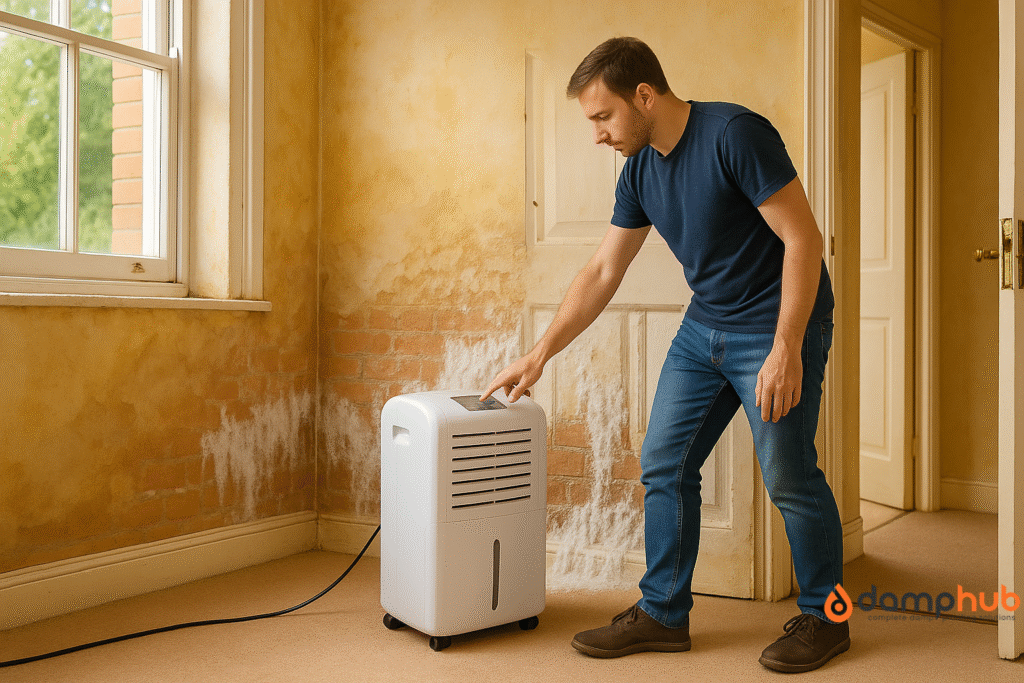
Step 2: Brush It Off
Once the area is dry, use a stiff brush to remove the powder. No water, no chemicals. Just a dry brush.
Why? Because water activates more salts. Wet scrubbing often makes things worse.
Do it gently. You don’t want to scuff the brick or push salts deeper.
Step 3: Clean With Acid (Only If Needed)
Still not gone? You can use a mild acid cleaner like diluted white vinegar or a proprietary brick cleaner (read the label—some are too strong for softer bricks).
Apply with a sponge or low-pressure spray. Let it sit briefly, then rinse thoroughly. Never use a power washer—it drives water and salts deeper into the wall.
Preventing Efflorescence for Good
You can’t remove all salts from brick or concrete. But you can stop the moisture that brings them out.
1. Improve Drainage Around the Building
Efflorescence often starts with poor drainage. Make sure:
- Gutters and downpipes work and don’t spill water down the walls.
- Ground slopes away from the house, not toward it.
- Patio or driveway doesn’t pool water near your foundations.
- French drains or soakaways move water away properly.
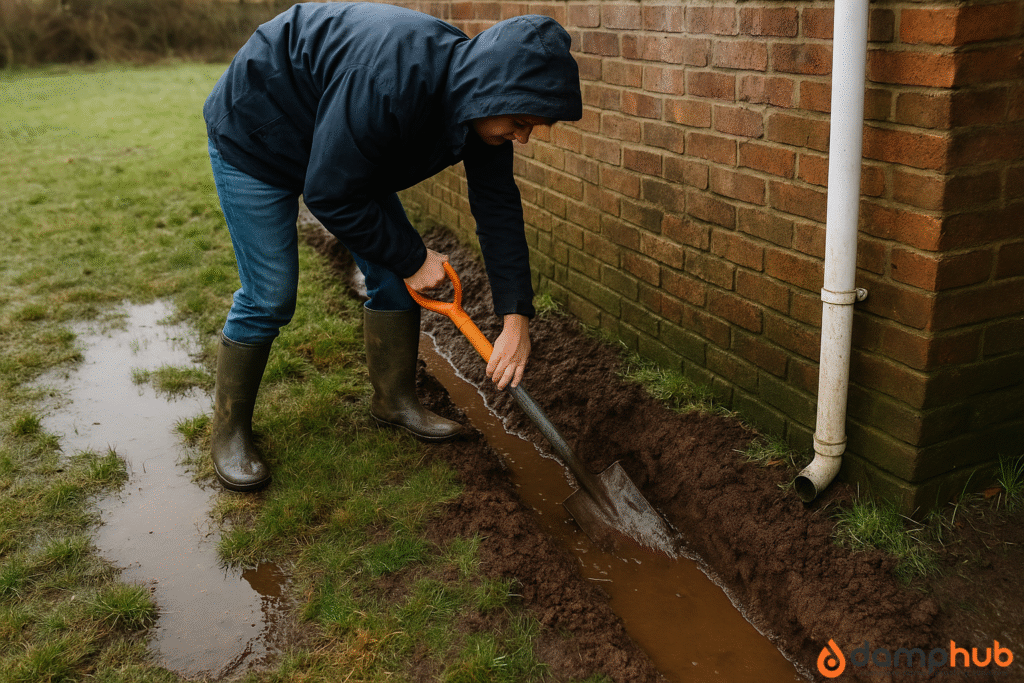
2. Repoint and Repair Damaged Masonry
Gaps in mortar joints or cracked render give water a path in. Repoint with the right mortar for your brick (especially if you’ve got soft Victorian stock).
Avoid hard cement mortar on old bricks—it traps moisture and makes problems worse.
3. Protect New Brickwork From Rain
Building an extension or repointing a wall? Cover it during wet weather. Bricks soak up water fast during building work, especially if left uncovered.
Once dry, you can apply a breathable masonry water repellent—but only if you’re sure the wall is dry and well-pointed.
Avoid clear sealants that trap water inside.
4. Treat Rising Damp (If That’s the Cause)
If efflorescence shows up near ground level, rising damp might be to blame. Look for:
- Salt lines on the bottom of the walls
- Plaster “blowing” or crumbling low down
- Tiled or wooden floors lifting or warping
You may need a chemical DPC injection or to replace the damp-proof course entirely. This isn’t a DIY job—call a damp specialist.
👉 Related Blog: How to Treat Rising Damp: A Complete Guide for UK Homeowners

Internal Efflorescence—When It’s Inside the House
Efflorescence on internal walls is a sign that something’s gone very wrong behind the scenes. It usually means:
- Water is seeping through the external wall
- The cavity is bridged (e.g. rubble or insulation holding moisture)
- Internal plaster is drawing moisture from the brick
You’ll often spot:
- White streaks under flaking paint
- Powder pushing through under the wallpaper
- Damp smells or mould nearby
Fixing this means removing the plaster, drying the wall properly, and fixing the external issue. Then re-plaster with breathable materials like lime or renovating plaster.
When Efflorescence Turns Into Spalling
Here’s where things get ugly.
If salts build up under the surface and don’t escape fast enough, they expand. That expansion can pop bits of the brick face off, called spalling. It’s especially common in frost-prone areas.
Once bricks start crumbling, there’s no patching them. You’ll need to cut out and replace the damaged ones.
Don’t ignore flaking bricks. It means the wall is absorbing water, and it’ll only get worse.
When to Call in a Pro
Call a damp or masonry specialist if:
- Efflorescence keeps coming back after cleaning
- Internal plaster is crumbling or lifting
- You suspect rising damp or cavity bridging
- Bricks are flaking or crumbling (spalling)
- The affected area is large or in a basement
Ask for a proper damp survey—not just a builder’s guess. You need to know if the issue is surface-level or structural.
Final Thoughts
Efflorescence is your home’s way of saying, “There’s moisture here—and it’s moving.”
It might look like a minor cosmetic issue, but it’s a red flag for deeper damp problems. Catch it early, and it’s a cleanup. Leave it too long, and you’re replacing bricks, plaster, and potentially footing a structural repair bill.
Look after your brickwork. Watch for the signs. And when white powder shows up? Don’t just brush it off and walk away.
FAQs
Which building materials are most susceptible to efflorescence?
Porous materials like concrete, brick, mortar, stucco, and natural stone are highly susceptible due to their ability to absorb and transport moisture.
Is efflorescence a structural defect?
No, efflorescence is mainly cosmetic.
However, its presence often indicates moisture intrusion, which can lead to more serious issues like dampness, mould, or material degradation if not addressed.
What are the three precautions to be taken while constructing the building to minimise efflorescence?
1. Use Low-Alkali and Washed Materials
– Choose low-alkali cement and clean, salt-free sand and aggregates.
– Avoid using water that contains dissolved salts for mixing mortar or concrete.
– This reduces the amount of salt available to cause efflorescence.
2. Ensure Proper Waterproofing and Drainage
– Install effective damp-proof courses (DPC), membranes, and cavity wall insulation.
– Ensure the site has proper slope and drainage to divert water away from foundations and walls.
– Prevent moisture ingress from below and around the structure.
3. Limit Water Content in Mortar and Concrete
– Avoid over-watering during mixing or curing processes.
– Use admixtures to reduce permeability and control the setting.
– Excess water makes it easier for salts to dissolve and migrate to the surface.
Can paint stop efflorescence?
No, paint alone cannot stop efflorescence.
While it may temporarily hide the stains, it doesn’t address the underlying cause, which is moisture carrying salts to the surface.
If the source of moisture isn’t eliminated, the efflorescence will eventually reappear, often causing the paint to blister, peel, or flake.
What happens if you seal over efflorescence?
Sealing over active efflorescence can trap moisture and salts inside the material. This may lead to:
– Increased pressure beneath the sealant or paint layer
– Blistering or bubbling of the coating
– Worsened surface staining once the seal fails
– Accelerated material degradation beneath the surface
It’s essential to fully clean and dry the surface and resolve any moisture ingress issues before applying sealants or coatings.
How does temperature affect efflorescence?
Temperature influences efflorescence in two main ways:
– Evaporation Rate:
Warmer temperatures speed up evaporation, which encourages salt deposits to appear on the surface more quickly.
In cooler conditions, evaporation slows down, so salts may remain inside the material longer.
– Moisture Movement:
Rising temperatures can draw moisture (and dissolved salts) to the surface, especially in porous materials like brick or concrete.
However, if the surface dries too fast, salts may crystallise below the surface, causing sub-efflorescence, which can lead to internal cracking.
Why is efflorescence minimal during humid conditions?
Efflorescence tends to be lower in high humidity because:
– Slower evaporation: In humid air, water evaporates more slowly, so salts stay dissolved and don’t crystallise on the surface.
– Surface remains damp: When the surface doesn’t dry out, the salt solution can’t leave visible deposits.
– Less visible residue: Even if salts are present, they don’t dry and form powdery stains as easily.
Does rising damp cause efflorescence?
Yes. Rising damp is a major cause of efflorescence.
As groundwater moves upward through porous building materials like bricks or mortar, it carries dissolved salts.
When the moisture reaches the surface and evaporates, those salts are left behind, forming white, powdery efflorescence.
What is the difference between efflorescence and dampness?
– Efflorescence is the visible salt deposit on a surface, usually white and powdery. It’s a symptom of moisture movement through building materials.
– Dampness refers to excess moisture within walls, floors, or ceilings. It can be caused by rising damp, leaks, condensation, or poor ventilation.
Dampness may or may not result in efflorescence.
Efflorescence cannot occur without some form of dampness or moisture movement.
What are the problems with efflorescence?
While often cosmetic, efflorescence can lead to:
– Blistered paint or flaking finishes
– Surface staining and discolouration
– Decreased structural durability if salts accumulate inside materials
– Misdiagnosis of moisture problems, delaying proper repairs
– Potential indoor air issues if combined with other damp symptoms like mould
How long does efflorescence take to form?
Efflorescence can appear within a few days to several weeks after construction or exposure to moisture.
In new construction, it’s common within the first 2–4 weeks, especially in porous materials.
In older buildings, it may show up any time moisture enters the structure and starts to evaporate through the surface.


